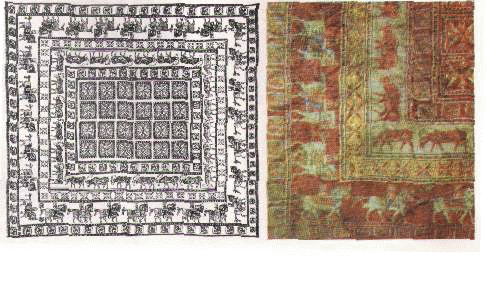

![]()
Il tappeto, questo sconosciuto...
![]()
Between theory and practice
"Carpet" is normally meant to be the knotted one and, that is, a particular, decorated fabric, done by hand with the "knotting" technique in order not to get a usual flat fabric, but a fleece that hides its holding structure - the armour. This in turn is made up of the grid, shaped by the weaving of horizontal threads (the woof) with other vertical threads (the warp). The knotting technique has a row of horizontal knots, usually woven on two of the warp's chains, alternating at one or more of the woof runs. After each little knot, the thread is cut so to get that characteristic "tuft," which, combined with many others, makes up the carpet's fleece. In order to make the design, therefore, knots with different color threads are made, proceeding as if each knot corresponds to the tessera of a mosaic that is to be put together.
There
are various ways to knot a carpet, the raw material, instead, is always constant
- wool, cotton, and, for some models, silk.
These are, though, fibers that are subject to deterioration due to their
own nature, especially wool, which with time crystallizes and, therefore, turns
to dust. The high perishability of the carpet's raw material, not considering
preservation, explains why there are scarce objective period documents available,
besides causing fundamental consequences for the chronological classification
criteria, let alone for the definition of the antique carpet.
In fact, if the period includes many centuries for paintings and
furniture, going from '300 up to '800, and in some cases to even more remote
eras, the carpet is already considered old when it is about 50-60 years old
and it comes to be part of the antique trade when it is over 100 years old.
In fact, some of the models from the '700s are found, in fragments, only
in a few museums.
Where and why the knotted carpet was born make up two of the basic questions that, though, have yet to get definite answers since concrete documented evidence is missing. Nevertheless, it could be right to put the creation of this craftsmanship in a primitive and remote era, considering it carried out by nomadic and rude populations wanting to protect themselves from the cold ground without having to sacrifice the skins of their precious animals. The carpet was likely born, therefore, on rudimentary horizontal looms, easily taken apart or moveable with the precise utilitarian goal to substitute an artificial fleece for the natural one of the sheep and goat skins with which these populations kept warm, avoiding direct contact with the ground. At first, therefore, the intentions were exclusively practical and not artistic. Only some time later did the aesthetic pleasure come about, the desire to decorate the inside of their tents with these particular fabrics that would have then been given more colors and varied designs, becoming constant decorative motifs. Later, it is likely that the nomadic populations let their creation also be known to the village and city people, who made it their own, even bringing some modifications to the making with the introduction, for example, of the vertical looms.
The
most antique carpet was found around 1947 in Siberia, on the Altai Mountains,
precisely in the Pazyryk
Valley, from which it got its name, in a tomb belonging to a Sciita
chief, completely covered by ice and therefore, almost perfectly preserved.
Entirely made of wool and with motifs representing a sequence of horsemen
and elks, this model can be dated back to around the V
century b.c. Given the
area where it was found makes one think that the initial use of the carpet was
developed in the Turkestan area from
where, following the migrations, it spread towards west to Persia, Caucasus, and Anatolia, towards east to Cina
and, later, towards south to India.

How
to recognize a good carpet…
This
subject, amongst the most difficult to deal with, for, as in every other piece
of art, the carpet requires wide knowledge and experience and universal norms do
not exist by which can be said, "This carpet is good, this other one is not."
It is surely fundamental to know the model's origin, but it is just as
important to estimate the raw material and the technique used to make it, the
type of knot, and the density of these (this is not an absolute value either).
It is therefore necessary to be able to look at a piece as a whole and it
is for this reason that, unfortunately, a long testing period is necessary.
One thing, though, we can tell you, distrust the easy buys, the offers
(the carpet, when it is good, is an investment and, as such, no offer or sale
can be made on it) from deceiving advertisements, place your trust in who really
knows the Oriental carpet and not in the first "quack" that you come
across. Now, think that in the
purchase of a carpet, for every small amount of invested capital you save
generally implies the loss of a large amount of the product's quality, thus the
saying, "Who spends more, spends better" is true.
The Oriental Carpet
![]()
This site is
better with ![]() at
a resolution of 800 x 600 pixel.
at
a resolution of 800 x 600 pixel.